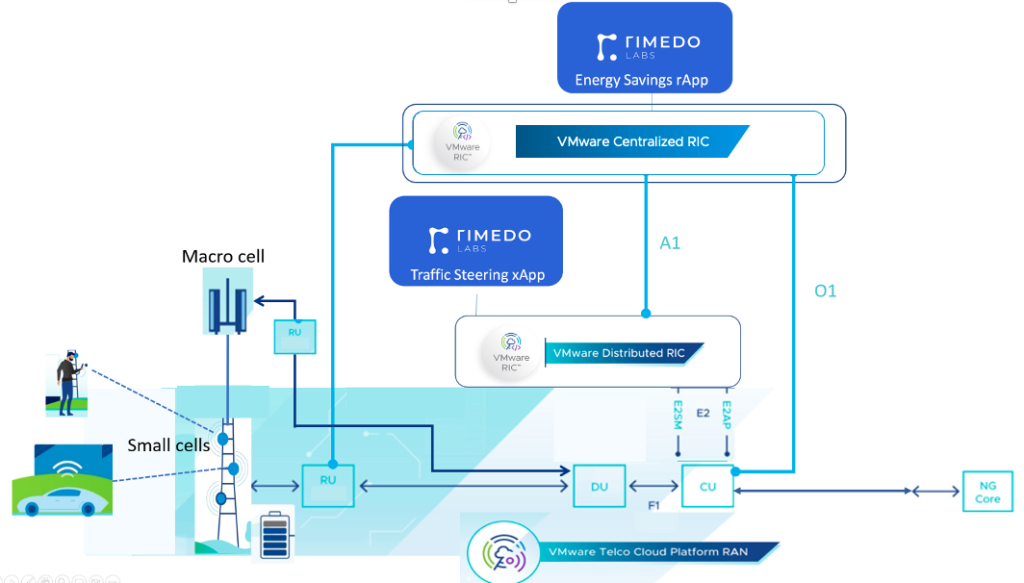Rimedo Labs xApp Running on VMware Distributed RIC Demonstrates Dynamic Approach to Saving Energy at the O-RAN Global PlugFest
The O-RAN Alliance’s architecture for an open, disaggregated RAN promises a future where multiple platforms and applications from different vendors work together in harmony to optimize the network, create new services for subscribers, and deliver greater efficiencies for the host mobile operator. At this year’s O-RAN Global PlugFest Spring 2023, which was held at the i14y Lab hosted by Deutsche Telekom and EANTC at their Berlin campus, VMware and Rimedo Labs successfully demonstrated a use case showing how O-RAN concepts can be used to drive down energy usage through policy-driven traffic steering.
The O-RAN architecture is designed to support multiple integrated applications using standard interfaces to interact with each other and the RAN elements. One component, the RAN intelligent controller, or RIC, hosts applications that can control other network elements and manage network functions such as radio resource management, congestion control, and mobility management. Applications can work together to implement different features in order to optimize the network or support new services for subscribers.
The RIC has two forms: the near-real-time RIC, which runs xApps, and the non-real-time RIC, which runs rApps. Both forms of the RIC can work together. Applications hosted by the near-real time RIC, for example, can make policy-based decisions informed by centrally collected data from the non-real time RIC. This combination ensures that changes made to the network are in response to dynamic real-time conditions as well as overall business objectives.
Integration through Standard O-RAN Interfaces
The PlugFest demonstration by VMware and Rimedo consisted of an integrated solution using a Rimedo Traffic Steering xApp hosted on the near-real-time RIC from VMware, called VMware Distributed RIC, which received policy information from a Rimedo Energy Savings rApp using a RAN simulator provided by Rimedo.
The integration was achieved by using standard O-RAN Interfaces:
- The O1 interface was used to provide the rApp with network data retrieved from the RAN Simulator
- The A1 interface was used by the rApp to update policy information on VMware Distributed RIC
- The E2 interface was used to update the RAN based on decisions made by the xApp.
The Rimedo Traffic Steering xApp was the award winner at the inaugural rAppathon contest for RIC application developers hosted by VMware and Intel at MWC Barcelona 2023. The xApp performs traffic steering by taking into consideration both service-based and load-based factors as well as centralized policies determined by the network operator. In the PlugFest demonstration, the policies were automatically updated by an Energy Savings rApp. The solution showed how the network can be automatically updated to minimize energy usage while ensuring compliance with subscriber SLAs.
Incorporating Both Mobility and Service Load Balancing
Unlike traditional traffic steering mechanisms that are typically limited to using radio conditions on a cell to determine where to steer traffic, Rimedo’s Policy-Controlled Traffic Steering xApp, powered by VMware Distributed RIC, incorporates both service and mobility load balancing to avoid congestion and improve user experience. The addition of policy updates provided by the Energy Savings rApp adds a further dimension to the algorithm and ensures that this improved user experience is also combined with reductions in RAN energy usage.
The figure below shows how this use case could be realized in a mobile network, with the Traffic Steering xApp hosted on VMware Distributed RIC, and the Energy Savings rApp on the non-real-time RIC from VMware, called VMware Centralized RIC.

VMware is committed to nurturing a varied ecosystem of RIC application developers that can bring a wide range of benefits and features to mobile operators. VMware furnishes a highly scalable, multi-cloud, standards-compliant application hosting platform that fosters a diverse multi-vendor ecosystem, supports vendor interoperability, and empowers operators to tap pioneering solutions. These solutions introduce new use cases — such as automation, optimization, and service customization — that fuel innovation across a radio access network.
Lance Uyehara, Director of RIC Product Management at VMware, is enthusiastic about the outcome of the demonstration. “The use case we presented at this year’s PlugFest highlights how VMware RIC brings real intelligence to automated RAN updates. By combining real-time network data with business policies determined centrally, the RAN is constantly re-configured to adhere to customer SLAs at the lowest possible level of energy consumption. This is the power that a standards-compliant platform hosting innovative third-party applications brings to the industry,” Uyehara said.
Adrian Kliks, CTO at Rimedo, is equally upbeat: “Rimedo develops a range of different RIC applications that provide many different capabilities. By hosting our applications on VMware RIC, we can coordinate their behaviour and deliver real value to our mobile operator customers. The PlugFest allows us to showcase applications integrated with a real RIC using O-RAN compliant interfaces. This time we combined our new ES-rApp with TS-xApp, to make sure that the SLAs are assured when the capacity layer is switched off for energy saving purposes.”
Find out how VMware and Rimedo are helping CSPs take advantage of the O-RAN ecosystem to transform their legacy RAN and enter a new era of efficiency and service offerings:
Discover more from VMware Telco Cloud Blog
Subscribe to get the latest posts sent to your email.








